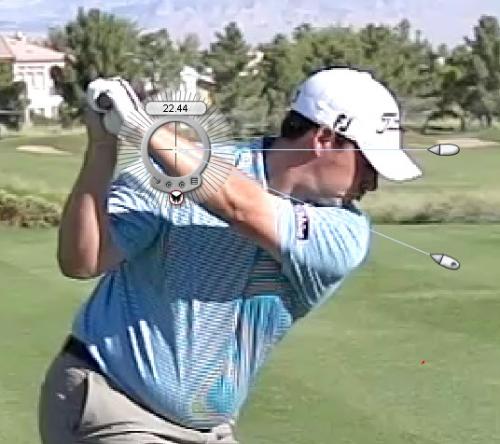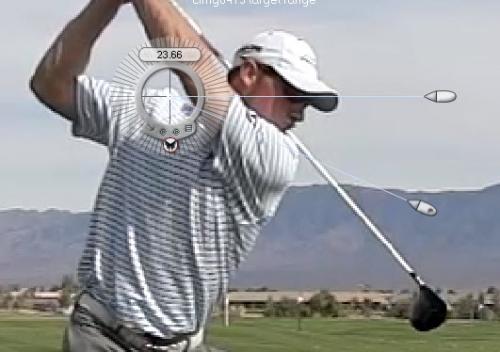Whats A Shoulder Turn? Part 2
- by Kelvin Miyahira
Last month’s article dealt with the thoracic spine extension (TSE), which most of the tour players use to execute and facilitate a good backswing shoulder turn. For this month, I’d like to get more in depth on the micro and macro movements of the upper torso/arms that will help you do a better backswing.
But first, let’s take a look at some commonly accepted norms about the relationship between the spine and the shoulder turn/tilt.
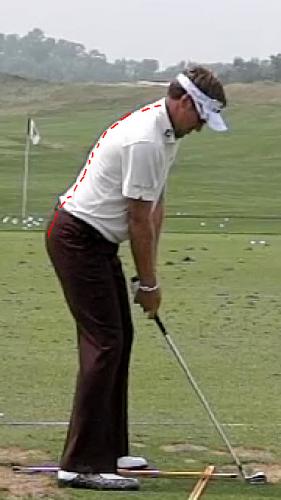
According to many golf experts our shoulders should turn perpendicular to the spine. Here’s Ian Poulter at address. So exactly which part of the spine should we turn perpendicular to???

I’ve drawn some blue lines that are roughly angled perpendicular to different points on his spine to help you get the right answer.
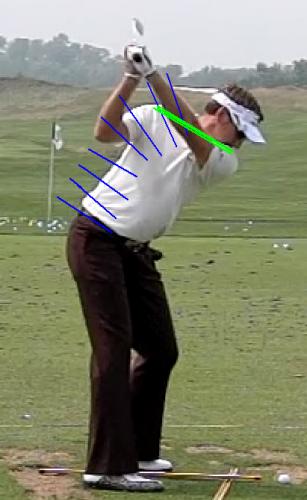
And the answer is…
Okay, it’s a trick question. We already know the spine is not straight at address. So how does one go about picking which part of the spine to turn perpendicular to?
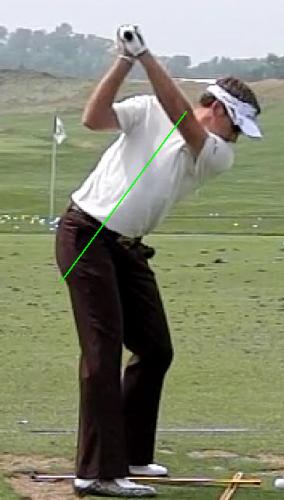
Or some just say at the top of the backswing, the shoulders should be perpendicular to the spine and they draw a line on anywhereland to supposedly show the spine’s position. I guess that line looks close to perpendicular to the shoulders…
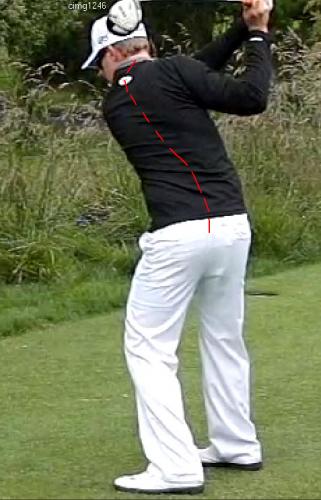
Oops. But the spine is not in a straight line at the top of the backswing either. So how do you make sense of this?
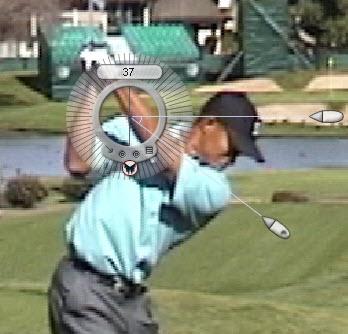
Thus, maybe for simplicity sake, you could just measure the angle of the shoulder tilt from horizontal? Tiger used to have his shoulders at 37 degrees tilted down from horizontal with an iron.
Now he’s at about 33 degrees tilted. Is that important?

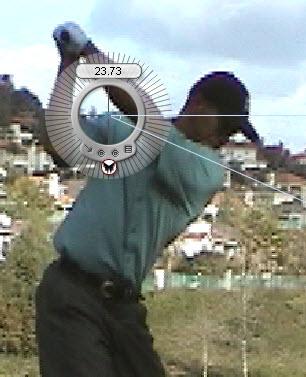
Here’s Hunter Mahan at about 27 degrees and Tiger at about 24 degrees tilted with their drivers. Obviously the length of the club you’re hitting will affect this tilt.
Next here’s an unknown tour player from the Justin Timberlake Classic vs. Jamie. They have similar shoulder tilt at about 23 degrees but they achieve this position in different ways.
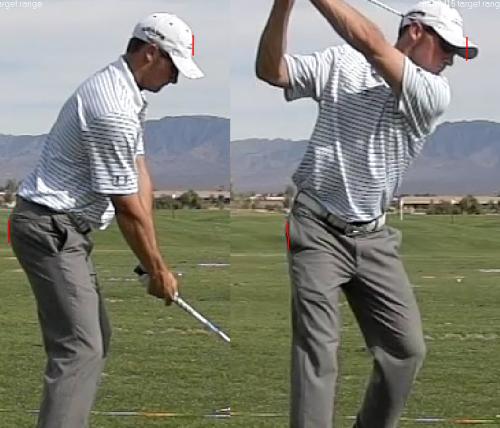
Jamie stands up slightly on the backswing thereby moving his head up and slightly away from the ball.

The tour pro moves his “tush” slightly forward toward the ball and achieves a similar shoulder tilt.
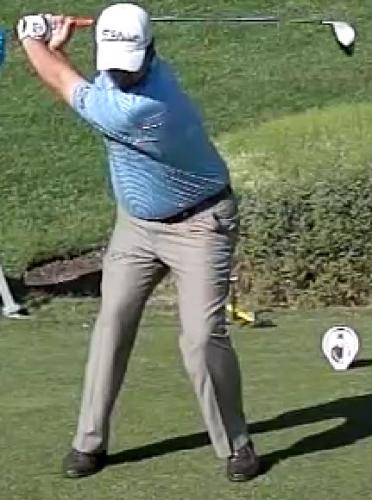
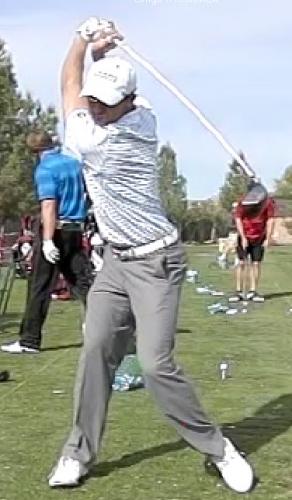
Yet, when looking from front view, there are a lot of differences that might explain the 100 yard difference in driving distance.
So maybe this whole concept of looking at a shoulder tilt is too vague and nondescript to be of any real value. Generally speaking, there’s a lot more going on with the spine, hips, lower body and even the arms. So maybe we ought to put our focus there?
So let’s start with the takeaway.
Takeaway
This first move is critical since many golfers get this wrong and can begin a chain reaction of other errors that are virtually impossible to fix since the earliest error is ignored. So how do we start the takeaway?
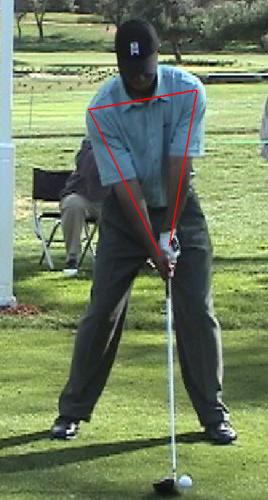
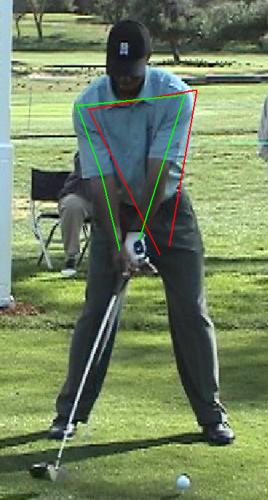
In the good old days, Tiger had a move off the ball or slight shift away from the target with his entire torso from his hips to his head. Also, he had some subtle arm swing motion separate from his shoulders. Can you see that the shoulders have moved more laterally while the right arm is bent slightly and left arm to shoulder angle decreased.
But I guess doing that which enables you to hit the ball 320 yards on the fly with an old Titleist 975D and a 43 ½” steel shaft isn’t important anymore.
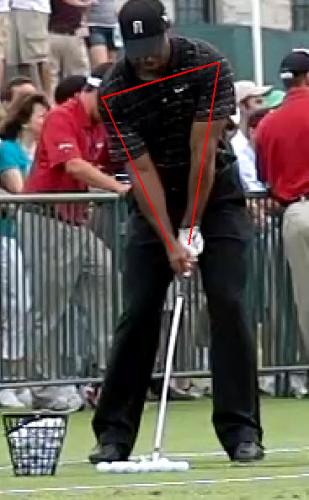
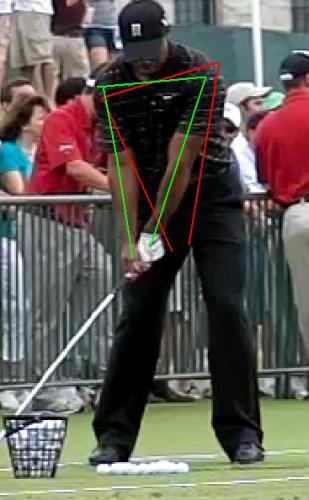
Notice Tiger now starts the backswing with some hip turn and left leg loading instead of shifting right. Notice his right leg is angled more to the target on the takeaway. Also his head dips down a bit and the shoulders tilt/turn instead of shifting right. By doing this, he keeps his triangle more intact. Some people think this is good. But if it leads to this…
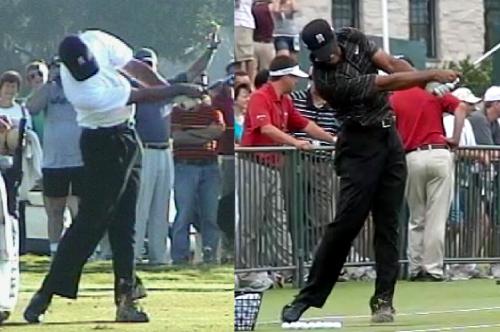
Does it mean anything to you Tiger? Peter Kostis says “new and improved” Tiger is turning better in 2011 than in 2010. But isn’t he comparing mopeds to mopeds? The old Tiger was a Ferrari. The picture on the left is from 2002. Both are iron shots.
See the left foot floating/rotating in the old Tiger? Also, his entire body was rotating. We don’t need the Konica Minolta swingvision camera to see the difference.
Arm Movements First

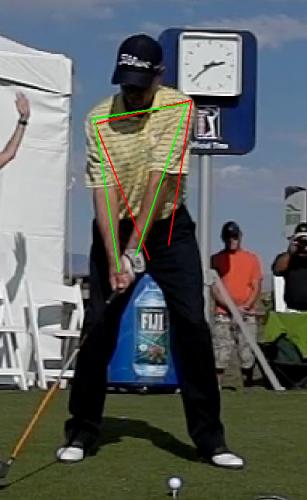
Look at the takeaway of next Ryder Cup captain Davis Love III whose classic swing has lasted for decades. He has some arm movement with very little shoulder turn in the takeaway. Like old Tiger, Davis’ shoulders to left arm angle is more acute after takeaway.
Knowing this, one notion that needs to be dispelled is the “one piece takeaway.” This could cause a stiff, robotic motion for the backswing that relies on the oblique muscles to rotate the entire spine to perform the takeaway.
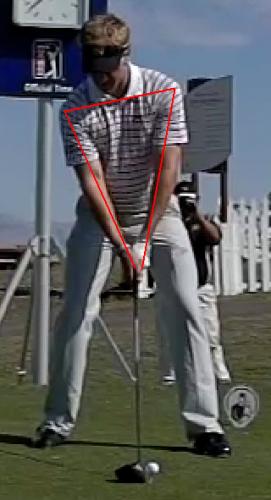
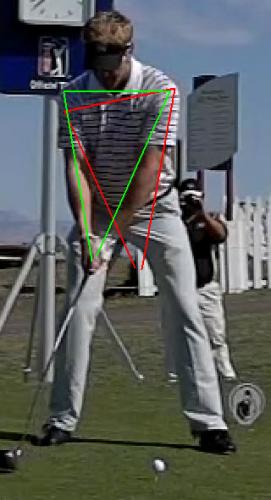
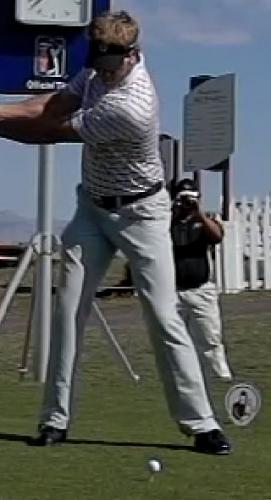
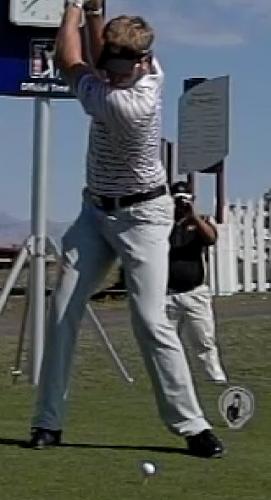
Here’s Ricky Barnes with his unorthodox swing. It starts with a one piece takeaway. Notice the triangle remains constant, thus he’s getting spine rotation in the takeaway. At about halfway through his backswing, he’s turned almost 90 degrees. Then can’t turn much more while his arms haven’t completed their movements so all that’s left for him to do is cervical spine extension. In other words, his head and cervical spine leans toward the target while his arms finish their range of movement. Some might call this a reverse pivot.
Movement Occurring in the Shoulder Joint
So let me more accurately describe the arm/shoulder micro movements of the takeaway that are occurring.
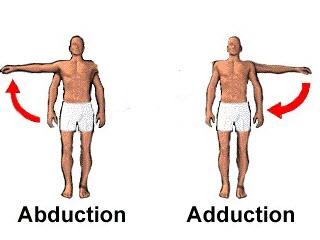
The arms are slightly moving independently of the spine in Davis’ takeaway. In anatomical terms, there is right arm abduction and left arm adduction. Adduction occurs as the left arm moves toward the center of the body. This is akin to a putting stroke where the arms are not locked to the torso and can swing freely from the shoulder joints.
Here’s a top view animation of the takeaway of Frank Greco aka Rory Jr. Notice the black spot we put on his spine. It does not begin to rotate till the end of the takeaway.
External/Internal Rotation of the Shoulder
Rory McIlroy shows a similar movement of the shoulders before the spine rotation occurs. So what is this movement? I put an arrow at the end of this animation to show Rory’s left elbow but it might be a little unclear as to what is happening. Perhaps a closer view of Jamie Sadlowski’s ripped arms would help.
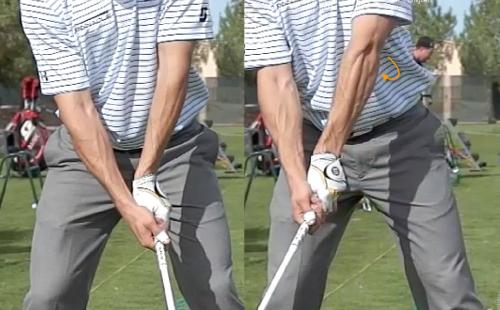
Now can you see it? What occurs to start the backswing is actually internal rotation of the left shoulder and external rotation of the right shoulder along with the abduction/adduction movements mentioned before.
Forearm/wrist movement counter movement


Here is probably the most complex part of the takeaway and backswing (this movement continues throughout the backswing) but it’s not that difficult once we break it down.
As seen above, the right forearm appears to be supinating as you can see the inner part of his forearm is rotated up while the left forearm appears to be pronating or rotating down. But this is not the case. This is part of the external/internal rotation of the shoulder that’s causing this movement.
The right wrist is not locked as you can see the wrist looked relatively flat at address changed to slightly extended (cupped) in the takeaway. Even the left wrist position has changed slightly. The left wrist started in an extended position then moved to a slightly less cupped position.
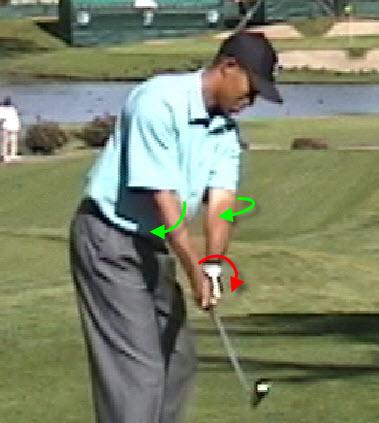
Perhaps this is a better viewpoint of this. While the left shoulder internal rotation/right shoulder external rotation is occurring in a clockwise direction, the forearms and wrists are moving to counteract this rotation.
Left wrist flexion or flattening from the cupped position at address is one part of it. Left forearm supination is also occurring to counteract the rotations in the left shoulder.
Suffice to say the right wrist is extending (cupping) along with right forearm pronation to counteract the rotations in the right shoulder as well.
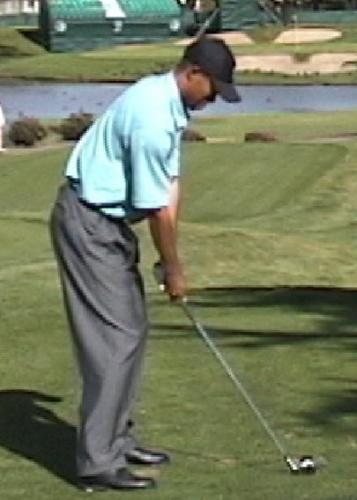
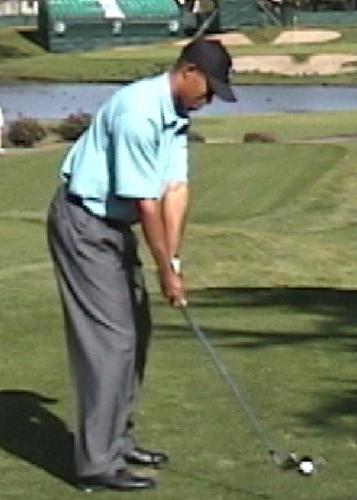

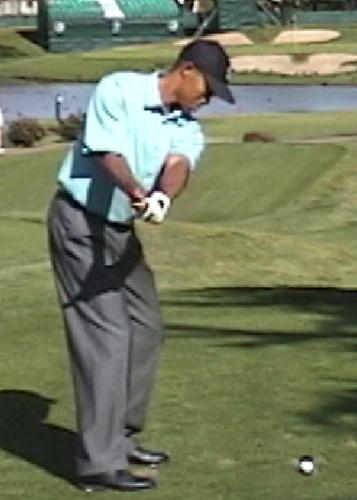

Thus, the key is that both forearms/wrists are ACTIVELY working throughout the backswing to inhibit the whole shoulder/forearm/wrist from rotating clockwise.
This is how the flat left wrist and what we call a “square clubface” are achieved at the top of the backswing of the old Tiger.
This may be a bit confusing at this point but let me show you a few examples of doing this differently that will surely clarify this.
Passive Wrist/Forearm with no counter movement
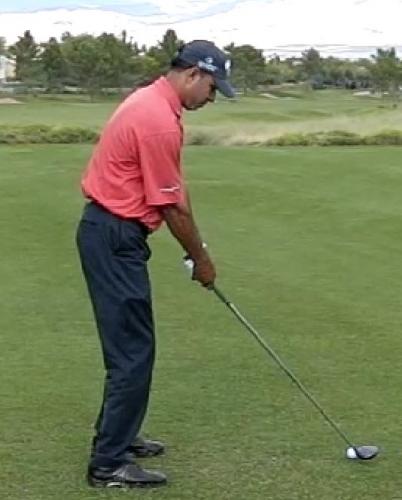
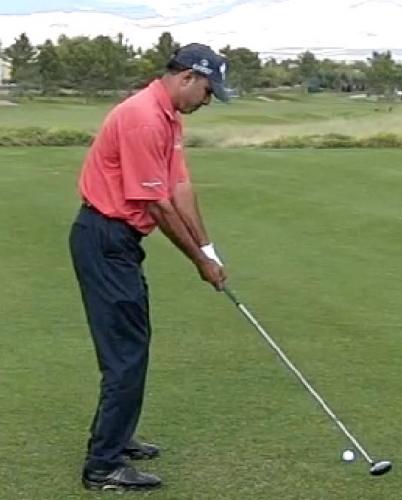
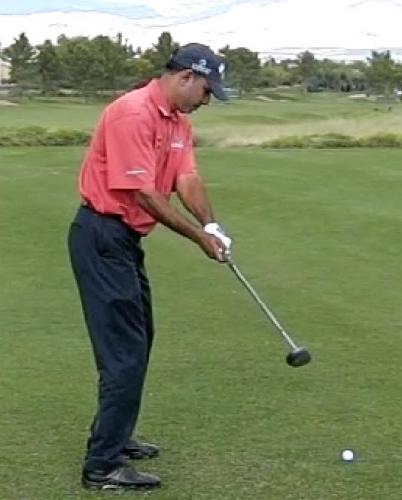
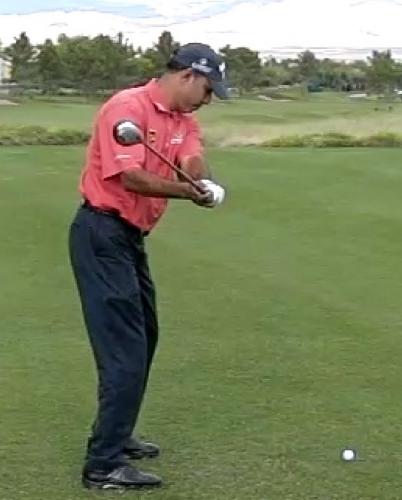
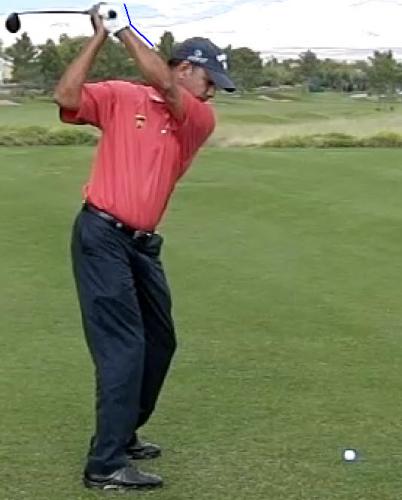
Here’s a little contrast if you don’t actively counteract the left arm internal rotation and right arm external rotation with correct wrist/forearm movements. Here’s Jeev Milkha Singh, who was ranked as high as 50th in the world golf rankings with this unorthodox backswing but he has tremendous ability to compensate for it (this means you’ll slice it if you don’t have all his compensations).
Notice that his entire left shoulder/arm/forearm are rotating clockwise. The left shoulder is internally rotating, while his forearm and wrist are doing the opposite of what Tiger did.
Instead, he is pronating or internally rotating his left forearm (rotating the palm down) and extending (cupping) his left wrist. This results in the open clubface that you can see.
Early Wrist Setting

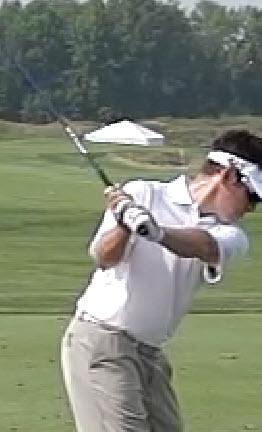
Much of golf instruction is filled with ambiguity and potential for creating unintentional errors. One of the biggest culprits is the early wrist cock or set. In order to set the wrists early, one must slightly cup the left wrist (which can possibly open the face too much), maybe not quite as drastic as Jeev, but enough to create some problems later in the swing. Look at the positions of Louie Oosthuizen and you can see the cupping of the left wrist from both angles.
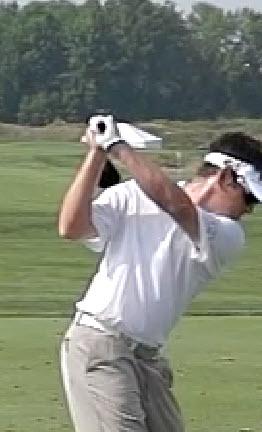
As you can see, this means the clubface is open a little more than is generally thought of as correct and it can create this…
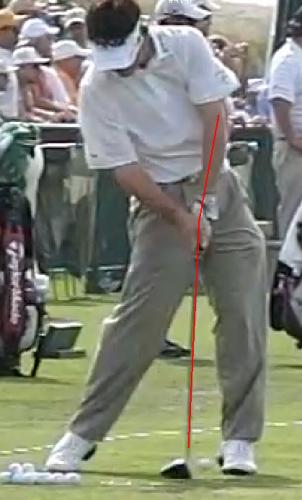
… a bit of a flip.
Early Wrist Cock and the Early Release

Here’s Ernie Els from 2006. He had the early wrist cock as recommended by his teacher at the time, David Leadbetter.
But look at what it causes? Setting the wrists so early causes stretch shorten cycle firings in his forearms that cannot be stopped no matter how good you are.
Dumbbell Drill
So here’s a simple drill you can do with a dumbbell that will simplify all of this for you.
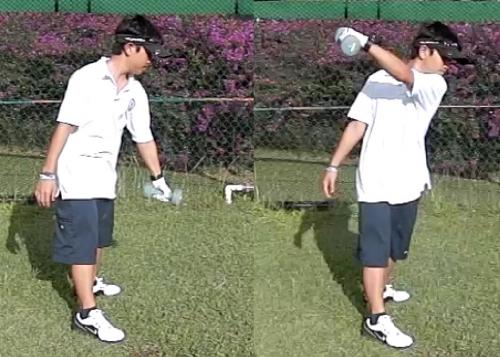
Kaleo is using a 7 pound dumbbell (can be lighter as well) to train left arm internal rotation and counter rotation of the wrist/forearm. Notice the flat left wrist at the top of the backswing.

The right arm can be trained in the same way. Right arm external rotation and counter rotation of wrist and forearm should be automatic. The weight is most easily supported by a supinated/cupped (palm up/extended right wrist). It should be natural to move into the “holding the tray” position.
Just for fun you can try to do the backswing like Jeev and see how much more difficult it becomes to support the weight.
Note: It is assumed that there is shoulder flexion (arm elevates) in all backswings. Maybe to varying degrees but it occurs in all golf swings.
Also, for the sake of simplicity, hip/leg movements are being left aside for later discussion.
Left Scapula Protraction phase
After the takeaway is completed, the “shoulder turn” starts with left scapula protraction or LSP. As the left scapula moves away from the spine, there is a gap or space forming between Dustin Johnson’s rib cage and his scapula. Creases in his sweater begin to form as this occurs.
Internal rotation of the left shoulder and arm elevation continues to occur in this phase as well.
The main muscles at work here are the serratus anterior (boxer’s muscles), pectorals and levator scapulae that are at work. These are the same muscles you would use to throw a punch.
Feel Drill
Here’s a simple drill to feel LSP. First, while seated, try turning while crossing your arms over your chest. This will restrict your scapula from protracting. See how much you can turn.
Next, use your left arm to throw a punch at an imaginary person standing to your right. By using your punching muscles, you can feel the muscles that are involved in pulling your left side in rotation. You should also feel separation of the scapula away from the spine. While crossing your arms over your chest, you will lock the main muscles involved and perhaps not use them.
Right Scapula Retraction phase
Right Scapula Retraction (RSR) begins just slightly after the LSP starts and it should finish off the backswing.
RSR is accomplished by using the large muscles on your back to contract and this pulls the scapula back toward the middle of your spine. The major muscles involved are your latissimus dorsi, rhomboids and trapezius. Smaller but equally important muscles of the rotator cuff are at work as well. These include the teres minor, supraspinatus and infraspinatus.
These muscles rotate the right side of your torso.
Take a look at the muscular back of Franz Schwarzenegger (Keenan) as he completes the backswing. Is there any doubt that the muscles on his back are pulling on his scapula to rotate around the spine?
Independent Clavicle Movement
Independent movement of each clavicle is the norm for great ball strikers. While the simplistic understanding of the shoulders is that they turn perpendicular to the spine and moves in locked form, this is simply not the case.
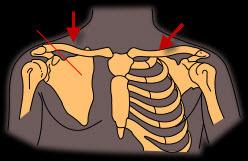
The red arrows are pointing to the clavicles on both sides. The clavicle (collarbone) is the bone running horizontally across from the sternum (breastbone) to the shoulder pointed out by the two red arrows (one on each side). As you can see, the clavicle is not one large bone spanning from shoulder to shoulder.
The key to understanding its optimal movements in a golf swing is the fact that the scapula and clavicle are free to move - not FUSED to the sternum (at the sternoclavicular joint) and glenohumeral (shoulder joint). These bones are attached to the pectoral, trapezius, deltoids, latissimus dorsi, rhomboids, serratus and other powerful muscles. Fusing or locking them together will transform these powerful prime mover muscles into stabilizers. Is that what you want?
Try This
Try it yourself. Leave the one shoulder still while moving the other shoulder about. You can move the right shoulder up, down, side to side and even circular motion (circumduction) without your left side moving. And it would be the same if you switch sides.
Then, try throwing a ball while fusing this entire complex together like a robot. Could you be powerful? Isn’t it obvious that you don’t throw with your arm? Since this is the case, why would anyone want it be frozen together in a golf swing?
The Evidence
Notice that the left shoulder is barely moving at the time the right scapula continues retracting. This illustrates that the right and left clavicle do not move in locked step.

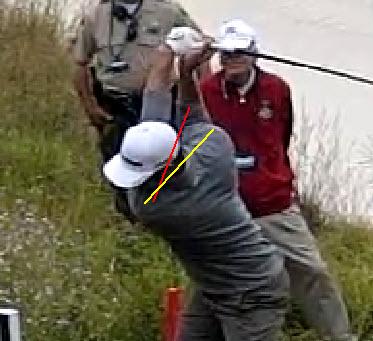
The red line marks the shoulder position at the beginning of the animation. The yellow line shows the new “shoulder turn” position after the right scapula has finished its retraction. It is apparent that the right clavicle pulled back farther than the left clavicle but if you don’t pay close attention, it just looks like it’s all moving together.
Here’s a better view of this same phenomenon. Watch Henrik Stenson’s right clavicle line move more than the left during the end of the backswing.

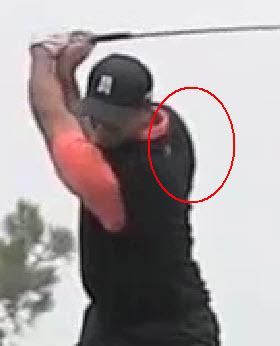
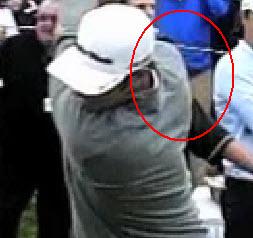
Notice that Trahan, without any right shoulder retraction, has a much smaller “shoulder turn.”
Sequencing
The backswings of Dustin Johnson and Henrik Stenson show that the torso does not move like a robot where both shoulders reach the end of the backswing at the same time. The left side definitely stops moving first, then the right shoulder and last the right elbow stops moving.
Many amateurs create excessive tension by trying to stop all of these moves at the same time and this typically triggers early firing from the top.
YouTube Scapula videos
I found an awesome display of scapula mobility exercises by Ido Portal using some resistance tubing. On one of his other videos I saw a huge poster of Bruce Lee in the background so obviously he knows something.
This next video should come with the disclaimer – Do Not Try This At Home!
http://www.youtube.com/watch?v=cAJlOeklpqQ&feature=mfu_in_order&list=UL
It’s pretty amazing what this guy can do. Perhaps more golfers should be trained like this instead of being trained like football players.
It’s Not Your Flexibility
Too many people believe that obtaining a bigger “shoulder turn” is dependent upon their body’s flexibility. Well, if you try to limit backswing hip turn, keep your spine stiff and straight, you can easily have your backswing limited by flexibility.
But it doesn’t have to be that way……
Perhaps 75 year old Donald Chow can show you that getting a bigger backswing shoulder turn may have more to do with the level of your intellectual flexibility than your physical flexibility.

In the before swing, he has less than 90 degrees of “shoulder turn.” A few swings later, he’s got TSE, LSP, RSR and a huge backswing.
This isn’t rocket science, but you do have to conceptually understand what the pros are doing first, before you can do these movements. Instinctually, you may not have done this, but it doesn’t mean you can’t change.
I hope I’ve clarified some of the problems that are created by oversimplification of complex movements in the spine and body. To think that the spine stays stiff or straight (it is NOT straight anyway) while the shoulders rotate around it, severely reduces the possibility that you’ll perform a proper backswing.
Here are some videos to study.
- http://www.youtube.com/watch?v=uFiJ1E5YFLU
- http://www.youtube.com/watch?v=7GJVzA1OheI
- http://www.youtube.com/watch?v=_fSURWAkGS4
- http://www.youtube.com/watch?v=5j17CHT9tlk
- http://www.youtube.com/watch?v=_qjyWTfQwx8
- http://www.youtube.com/watch?v=b86gHKSavLc


